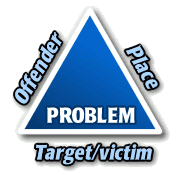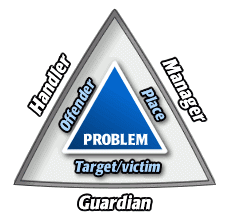The Problem Analysis Triangle
While the SARA model is useful as a way of organizing the approach to recurring problems, it is often very difficult to figure out just exactly what the real problem is. The problem analysis triangle (sometimes referred to as the crime triangle) provides a way of thinking about recurring problems of crime and disorder. This idea assumes that crime or disorder results when (1) likely offenders and (2) suitable targets come together in (3) time and space, in the absence of capable guardians for that target. A simple version of a problem analysis triangle looks like this:

Offenders can sometimes be controlled by other people: those people are known as handlers. Targets and victims can sometimes be protected by other people as well: those people are known as guardians. And places are usually controlled by someone: those people are known as managers. Thus, effective problem-solving requires understanding how offenders and their targets/victims come together in places, and understanding how those offenders, targets/victims, and places are or are not effectively controlled. Understanding the weaknesses in the problem analysis triangle in the context of a particular problem will point the way to new interventions. A complete problem analysis triangle looks like this:

Problems can be understood and described in a variety of ways. No one way is definitive. They should be described in whichever way is most likely to lead to an improved understanding of the problem and effective interventions. Generally, incidents that the police handle cluster in four ways:
- Behavior. Certain behavior(s) is (are) common to the incidents. For example, making excessive noise, robbing people or businesses, driving under the influence, crashing vehicles, dealing drugs, stealing cars. There are many different behaviors that might constitute problems.
- Place. Certain places can be common to incidents. Incidents involving one or more problem behaviors may occur at, for example, a street corner, a house, a business, a park, a neighborhood, or a school. Some incidents occur in abstract places such as cyberspace, on the telephone, or through other information networks.
- Persons. Certain individuals or groups of people can be common to incidents. These people could be either offenders or victims. Incidents involving one or more behaviors, occurring in one or more places may be attributed to, for example, a youth gang, a lone person, a group of prostitutes, a group of chronic inebriates, or a property owner. Or incidents may be causing harm to, for example, residents of a neighborhood, senior citizens, young children, or a lone individual.
- Time. Certain times can be common to incidents. Incidents involving one or more behaviors, in one or more places, caused by or affecting one or more people may happen at, for example, traffic rush hour, bar closing time, the holiday shopping season, or during an annual festival.
There is growing evidence that, in fact, crime and disorder does cluster in these ways. It is not evenly distributed across time, place, or people. Increasingly, police and researchers are recognizing some of these clusters as:
- Repeat offenders attacking different targets at different places.
- Repeat victims repeatedly attacked by different offenders at different places.
- Repeat places (or hot spots) involving different offenders and different targets interacting at the same place.
The Problem Analysis Triangle was derived from the routine activity approach to explaining how and why crime occurs. This theory argues that when a crime occurs, three things happen at the same time and in the same space:
- a suitable target is available.
- there is the lack of a suitable guardian to prevent the crime from happening.
- a motivated offender is present.
Check out the list of readings under the POP Center recommended readings.
